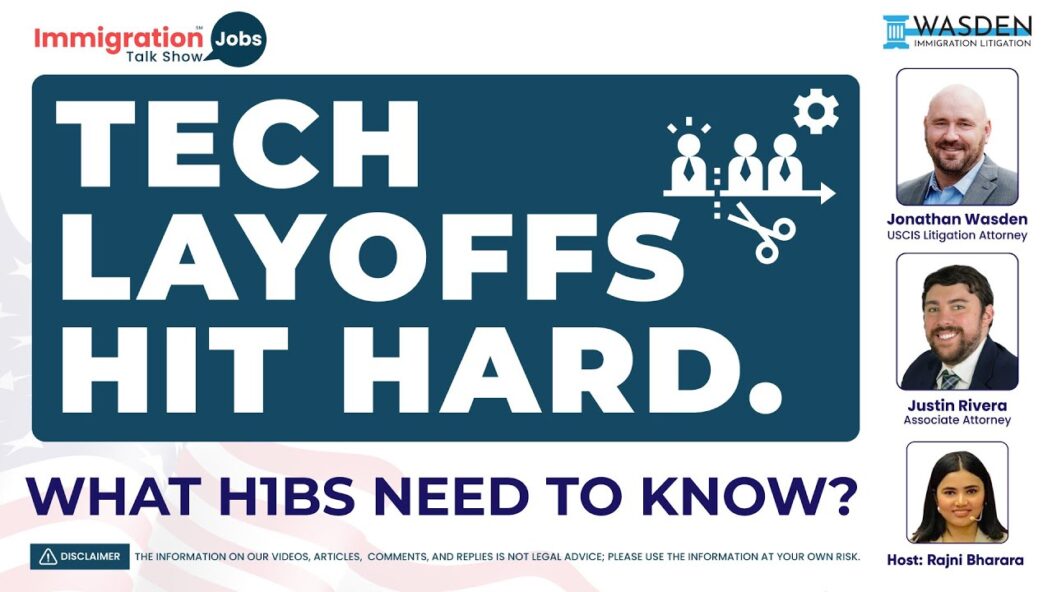Grab your coffee and settle in, because we need to talk about something that’s happening right now in immigration that’s frankly terrifying – and you might be next.
Picture this: You’re an H-1B worker. You’ve been playing by every single rule in the book. Your employer laid you off through no fault of your own, but you’re not panicking because you know you have that 60-day grace period. You even went ahead and filed your change of status application within the first week. You’re doing everything right.
Then your doorbell rings, and there’s an official document waiting for you. A Notice to Appear. Deportation papers.
“But wait,” you’re thinking, “I’m still legal. I’m in my grace period. I filed my application. This has to be a mistake.”
It’s not a mistake. It’s the new reality, and it’s happening to people just like you all across the country.
The Story That Started It All
Let me tell you about Sarah (name changed for privacy). She’s a software engineer who was working for a tech company in San Francisco on her H-1B. In April, her company had layoffs. She was devastated, but she knew the drill. She had 60 days to figure things out.
Sarah did everything by the book. She filed her H-4 change of status application within the grace period. Her I-94 hadn’t even expired yet. She was checking all the boxes, following every rule that USCIS had laid out.
Then, on June 9th, she got her Notice to Appear.
The NTA said she was removable under sections 237(a)(1)(B) and (C) of the Immigration and Nationality Act. It claimed she had been unlawfully present starting from April 8th – the day her H-1B was withdrawn. Never mind that she was in her grace period. Never mind that she had a pending application. Never mind that her I-94 was still valid.
According to USCIS, she was suddenly deportable.
Sarah’s not alone. Immigration attorneys across the country are seeing this same pattern, and frankly, we’re all scratching our heads wondering what the hell is going on.
What People Are Saying Behind Closed Doors
The immigration law community is buzzing with reports of this troubling trend. Attorneys from coast to coast are reporting similar cases, with many describing it as unprecedented in their decades of practice. The prevailing sentiment is one of disbelief that USCIS would essentially disregard their own regulations.
Legal professionals are expressing concerns about the agency throwing established policies out the window, creating a climate of uncertainty for clients who have been here legally for years and followed every requirement.
The fear in the immigrant community is palpable. H-1B holders are reporting increased anxiety about their status, with many saying they no longer feel secure even when following all the rules. Some are even receiving these NTAs after they’ve already left the United States voluntarily – a development that has legal experts particularly concerned.
The Technical Breakdown: What’s Actually Happening
Let me break down the legal stuff in plain English, because this is where it gets really messed up.
There’s this thing called Policy Memorandum PM-602-0187, issued by USCIS back in February 2025. It’s basically their own rulebook for when they’re supposed to issue NTAs. The memo is crystal clear: they should only issue an NTA “upon issuance of an unfavorable decision on a benefit request” and only when the person is not lawfully present.
But here’s the kicker – they’re not waiting for unfavorable decisions. They’re issuing NTAs while applications are still pending. They’re issuing them to people who are lawfully present under the 60-day grace period.
The regulation at 8 CFR 214.1(l)(2) couldn’t be clearer about the grace period. It says that H-1B workers “shall not be considered to have failed to maintain nonimmigrant status solely on the basis of a cessation of the employment” for up to 60 days.
There’s also this guidance from May 6, 2009 (yes, 2009 – this has been settled law for over a decade) that confirms when you file a timely, non-frivolous change of status application, you’re in a period of authorized stay and you don’t accrue unlawful presence.
So what’s USCIS doing? They’re acting like none of this exists.
Real Case Examples That Will Make Your Blood Boil
Let me share some more examples that attorneys have been reporting:
Case #1: The Pending I-485 This one really gets me. There’s a person whose H-1B petition was withdrawn, but they had a pending I-485 adjustment of status application based on an approved employment-based immigrant petition. Under established USCIS policy, people with pending I-485 applications are in authorized stay. They don’t accrue unlawful presence. This is Immigration Law 101.
But USCIS issued an NTA anyway, claiming this person was present without authorization. It’s like they forgot their own rules.
Case #2: The Person Who Left Here’s one that’ll really make you mad. Someone’s employment ended, they decided to leave the U.S. voluntarily rather than use their grace period. They left the country shortly after their job ended.
USCIS still issued them an NTA. For someone who wasn’t even in the United States anymore.
Case #3: The Textbook Case This person lost their job, was still within the 60-day grace period, filed a change of status application within two weeks, had all their documentation in order. Legal experts describe it as a “textbook case” of how to handle a job loss properly.
They got an NTA anyway.
What Immigration Lawyers Are Really Thinking
The legal community is expressing serious concerns about what this means for the rule of law. Many attorneys are pointing out that this isn’t just about individual cases anymore – it’s about whether USCIS policies have any meaning if the agency can simply ignore them at will.
Legal professionals are also highlighting the strain this puts on an already overburdened immigration court system. Immigration courts are already backed up for years, and now they’re being flooded with cases that shouldn’t exist under current policy.
Perhaps most frustrating for the legal community is that there’s been no official announcement from USCIS about this change. No press release, no policy update, no guidance to attorneys. The agency is simply implementing a new practice without any formal notice.
The Fear Factor: What This Means for You
If you’re reading this and you’re on an H-1B, or you know someone who is, you’re probably feeling pretty anxious right now. And honestly? You should be.
Here’s what you need to understand: getting an NTA isn’t just an inconvenience. It starts removal proceedings. That means you have to appear before an immigration judge. Even if the judge eventually dismisses the case (which they should, if the NTA was improper), you’ve now got a record in the immigration court system.
If you leave the U.S. after getting an NTA but before your court date, it could be considered a “self-removal,” which can trigger re-entry bans. We’re talking about consequences that could affect you for years, even if you did nothing wrong.
And here’s the really scary part – this is creating a climate of fear where people are making decisions based on panic rather than following established procedures. Some people are leaving the U.S. immediately when they lose their jobs instead of using their lawful grace period, because they’re terrified of getting an NTA.
How to Check If You’ve Been Hit
First things first – if you think you might have received an NTA, you need to check. Here’s how:
Online Check: Go to https://acis.eoir.justice.gov/en/ and enter your A-number (that’s your Alien Registration Number). This is the Executive Office for Immigration Review’s automated case information system. If you have a case, it’ll show up here.
Phone Check: Call 1-800-898-7180. This is the immigration court hotline, and they can tell you if you have a case in the system.
What to Look For: If you’ve received an NTA, it’s a formal document (Form I-862) that tells you that the U.S. government is initiating removal proceedings against you. Don’t ignore it. Don’t hope it goes away. Don’t think it’s a mistake that will fix itself.
The Action Plan: What You Can Do Right Now
Okay, so here’s where we get serious about fighting back. This isn’t just about individual cases – this is about holding USCIS accountable to their own rules. We need coordinated action, and we need it now.
Step 1: Congressional Pressure
We’re starting with the big guns. Congress has oversight authority over USCIS, and they need to hear from real people about what’s happening.
Letter to Senate Judiciary Committee:
Here’s a template letter you can customize and send:
The Honorable Alex Padilla Chair, Subcommittee on Immigration, Citizenship, and Border Safety Senate Committee on the Judiciary 224 Dirksen Senate Office Building Washington, D.C. 20510
The Honorable John Cornyn Ranking Member, Subcommittee on Immigration, Citizenship, and Border Safety Senate Committee on the Judiciary 152 Dirksen Senate Office Building Washington, D.C. 20510
Subject: Urgent Need for Oversight of USCIS’s Improper Issuance of NTAs
Dear Chairman Padilla and Ranking Member Cornyn:
I am writing as a concerned [citizen/resident/affected individual] about a disturbing pattern of conduct by USCIS that demands immediate congressional oversight.
USCIS Service Centers are currently issuing Notices to Appear (NTAs) to individuals who remain lawfully present in the United States under existing immigration regulations. Specifically, they are targeting:
- H-1B workers within their 60-day grace period who have timely filed change of status applications
- Individuals with pending I-485 adjustment applications who are in authorized stay
- People who have complied with every requirement of immigration law
This practice directly contradicts USCIS Policy Memorandum PM-602-0187, which clearly states that NTAs should only be issued “upon issuance of an unfavorable decision” when someone is not lawfully present.
[Include your personal story here if applicable – job loss, grace period, pending application, etc.]
The regulation at 8 CFR 214.1(l)(2) explicitly provides for a 60-day grace period. USCIS’s own May 6, 2009 memorandum confirms that people with pending change of status applications are in authorized stay and do not accrue unlawful presence.
Yet USCIS is ignoring all of this and placing law-abiding individuals into removal proceedings without legal justification.
I respectfully urge the Subcommittee to:
- Investigate this practice immediately
- Demand that USCIS explain why they’re violating their own policies
- Require USCIS to stop issuing NTAs to people in lawful status
- Hold hearings to ensure this doesn’t happen again
The integrity of our immigration system depends on agencies following the law, not making it up as they go.
Thank you for your urgent attention to this matter.
Sincerely, [Your name] [Your address] [Your contact information]
House Judiciary Committee Letter:
Send the same letter to:
The Honorable Tom McClintock Chair, Subcommittee on Immigration Integrity, Security, and Enforcement House Committee on the Judiciary 2138 Rayburn House Office Building Washington, D.C. 20515
The Honorable Pramila Jayapal Ranking Member, Subcommittee on Immigration Integrity, Security, and Enforcement House Committee on the Judiciary 2138 Rayburn House Office Building Washington, D.C. 20515
Step 2: Direct USCIS Pressure
These are the emails where USCIS actually listens (or at least, they’re supposed to):
Email #1: Public Engagement Division Send to: public.engagement@uscis.dhs.gov
Subject: “Immediate Action Required: Improper NTA Issuance Violating PM-602-0187”
Dear Public Engagement Division:
I am writing to report a serious violation of USCIS policy that requires immediate correction.
USCIS Service Centers are issuing Notices to Appear to individuals who remain in lawful status, directly contradicting Policy Memorandum PM-602-0187 dated February 28, 2025.
Specific Violations:
- NTAs issued to H-1B workers within the 60-day grace period under 8 CFR 214.1(l)(2)
- NTAs issued to individuals with pending change of status applications
- NTAs issued to individuals with pending I-485 applications who are in authorized stay
- NTAs issued without any unfavorable decision, contrary to PM-602-0187
Case Examples: [Include specific examples if you know any – dates, circumstances, etc.]
Required Legal Authority:
- 8 CFR 214.1(l)(2) expressly provides 60-day grace period
- May 6, 2009 USCIS memorandum confirms authorized stay during pending applications
- PM-602-0187 requires unfavorable decision before NTA issuance
Immediate Action Needed:
- Stop issuing NTAs to individuals in lawful status
- Clarify to Service Centers that grace period = lawful presence
- Confirm that pending applications = authorized stay
- Review and withdraw improper NTAs already issued
This practice violates fundamental due process and wastes government resources by clogging immigration courts with improper cases.
I expect immediate corrective action and a public clarification of policy.
[Your name and contact information]
Email #2: Policy Division Send to: policyfeedback@uscis.dhs.gov
Subject: “Policy Feedback: Violations of PM-602-0187 in Current NTA Practice”
Dear USCIS Policy Division:
I am providing feedback on the implementation of Policy Memorandum PM-602-0187, which is being violated by current USCIS practice.
The Problem: Service Centers are issuing NTAs in direct contradiction to the memorandum’s requirements. Specifically, they are issuing NTAs:
- Before any unfavorable decision is rendered
- To individuals who remain lawfully present
- While applications are still pending
Legal Analysis: PM-602-0187 Section VI clearly states NTAs should be issued “upon issuance of an unfavorable decision” when someone is not lawfully present. Current practice ignores both requirements.
The May 6, 2009 unlawful presence guidance (AFM Update AD 08-03) is established USCIS policy confirming that:
- Timely filed change of status applications toll unlawful presence accrual
- Pending I-485 applications provide authorized stay
- The 60-day grace period constitutes lawful presence
Specific Case Types Being Improperly Targeted:
- H-1B workers in 60-day grace period with pending COS applications
- Individuals with pending I-485 applications
- Workers who filed timely applications within grace period
Required Policy Clarification: Issue immediate guidance confirming:
- 60-day grace period constitutes lawful presence
- Pending applications provide authorized stay
- NTAs should not issue absent unfavorable decisions
- Service Centers must follow PM-602-0187 requirements
Impact: Current practice creates legal chaos, wastes judicial resources, and violates due process for law-abiding individuals.
Immediate corrective action is essential to restore policy compliance.
[Your name and contact information]
Step 3: Service Center and Director Contact
Letter to Service Center Operations:
U.S. Citizenship and Immigration Services Attn: Service Center Operations Directorate (SCOPS) 20 Massachusetts Avenue NW Washington, D.C. 20529-2060
Letter to USCIS Director:
U.S. Citizenship and Immigration Services Office of the Director (MS 2000) Camp Springs, MD 20588-0009
[Use similar content to the congressional letters, but focus on operational changes needed]
If You Get Hit: The Emergency Response Plan
If you receive an NTA, here’s what you need to do immediately:
Hour 1: Don’t Panic, But Act Fast
- Read the NTA carefully. Check every detail – your name, address, A-number, the charges against you, and the court date.
- Check for errors. Any mistakes could be grounds for dismissal. Wrong address? Misspelled name? Incorrect dates? Document everything.
- Take photos/scan everything. You’ll need multiple copies, and government documents have a way of disappearing.
Day 1: Legal Help
Contact Wasden Law immediately. Here’s why Jonathan Wasden is the attorney you want in your corner:
- Former DOJ and DHS attorney who used to defend the government in immigration litigation
- He knows how USCIS thinks because he used to work there
- Successfully overturned major USCIS policies in cases like ITServe v. Cissna
- Specializes in federal immigration litigation and Administrative Procedures Act challenges
Contact Us:
- Phone: (844) 592-7336
- Email: jon@wasden.law
- Website: wasden.law
- We handle cases nationwide!
Don’t wait. Don’t think it’ll resolve itself. Don’t hope the government will figure out their mistake. In immigration law, timing is everything.
Week 1: Document Everything
Gather every piece of paper related to your case:
- I-94 records
- H-1B approval notices
- Job termination documentation
- Application receipt notices
- Payment records
- Timeline of events
Create a clear timeline showing:
- Last day of employment
- When the grace period started
- When you filed any applications
- When the NTA was issued
The Bigger Picture: Why This Matters for Everyone
Here’s the thing – even if you’re not on an H-1B, even if you think this doesn’t affect you, it does. When government agencies start ignoring their own rules, it creates a precedent that can spread to other areas.
Today it’s H-1B workers in their grace period. Tomorrow it could be students, or tourists, or anyone else the government decides to target with made-up interpretations of the law.
This is about the rule of law. It’s about whether we live in a country where agencies have to follow their own regulations, or whether they can just make stuff up as they go along.
What to Expect Moving Forward
Based on trends in immigration litigation and policy, here’s what we’re likely to see:
Short term (next 3-6 months):
- More cases hitting immigration courts
- Attorneys filing motions to dismiss improper NTAs
- Potential class action litigation
- Congressional attention (if we make enough noise)
Medium term (6-12 months):
- Court decisions on whether these NTAs are valid
- Possible policy clarification from USCIS (if pressured)
- Legislative hearings
- Administrative challenges to the practice
Long term:
- Precedent-setting court decisions
- Potential changes to grace period regulations
- Immigration court backlog getting worse before it gets better
The Technology Angle: How to Monitor Your Status
In today’s digital age, you can’t just wait for mail. Here’s how to stay on top of your case:
USCIS Case Status:
- Create an account at myuscis.uscis.gov
- Check status regularly
- Set up case alerts if available
Immigration Court System:
- Bookmark https://acis.eoir.justice.gov/en/
- Check weekly if you’re in a vulnerable situation
- Save the hotline number: 1-800-898-7180
Documentation:
- Screenshot everything
- Save all emails
- Keep physical copies of important documents
- Create a digital backup
The Human Cost
Let’s not forget what this is really about. We’re not talking about abstract legal concepts here. We’re talking about real people whose lives are being turned upside down.
These cases involve skilled professionals who have been in the U.S. for years, paying taxes, following every rule, and contributing to the economy. Many have families, children who were born here, and deep roots in their communities. Now they’re facing deportation for doing exactly what the law told them to do.
The psychological impact cannot be understated. People are reporting sleepless nights, anxiety attacks, and difficulty functioning at work. Families are making contingency plans for potential separation. Children are asking their parents if they’ll have to leave their friends and schools.
What Success Looks Like
Our goal here is simple: force USCIS to follow their own rules. That means:
- Immediate cessation of improper NTA issuance
- Public clarification that the 60-day grace period means lawful presence
- Review and withdrawal of improperly issued NTAs
- Clear guidance to Service Centers on proper procedures
- Congressional oversight to prevent future violations
This is achievable, but only if enough people speak up. USCIS responds to pressure – political pressure, legal pressure, and public pressure.
The Call to Action
As an immigration attorney, I’ve seen many concerning trends over the years, but this represents a fundamental breakdown in the rule of law. When government agencies can simply ignore their own written policies, we’ve crossed a dangerous line.
If you’re affected by this, don’t suffer in silence. If you know someone who’s affected, don’t assume someone else will handle it. If you’re not directly affected but you care about the rule of law, don’t think this isn’t your problem.
Here’s what you can do today:
- Share this information. The more people who know about this, the more pressure we can generate.
- Contact your representatives. Use those letter templates. Make the calls. Show up to town halls.
- Email USCIS. Flood their inboxes with complaints. Make this impossible to ignore.
- Support affected individuals. If you know someone dealing with this, help them find legal representation.
- Document everything. If you see or hear about cases, gather information that can be used in legal challenges.
Final Thoughts
The immigration system is already broken in a lot of ways, but at least until now, we could count on the basic principle that if you followed the rules, you’d be okay. If we lose that, we lose everything.
This isn’t just about H-1B workers. This isn’t just about immigration. This is about whether we live in a country where the government has to follow its own laws.
The fight for accountability starts now, and it requires all of us to speak up. The integrity of our legal system depends on it.
If you’ve received an improper NTA, contact Wasden Law at (844) 592-7336 or visit wasden.law. Don’t wait. Your future is too important to leave to chance.
Check your NTA status at: https://acis.eoir.justice.gov/en/
The time for action is now. Are you ready to hold the government accountable?
This blog post is for informational purposes only and does not constitute legal advice. If you have received an NTA or believe you may be affected by these issues, consult with a qualified immigration attorney immediately. Immigration law is complex and changes frequently, and individual circumstances vary significantly.
How useful was this post?
Click on a star to rate it!









